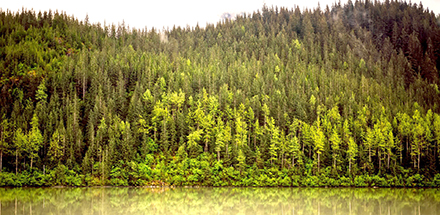
The Trump administration is seeking to lift federal protections on the Tongass National Forest in Alaska, paving the way for possible timber harvests and road construction in the largest national forest in the US. Source: NPR
Last week, the US Forest Service, part of the Department of Agriculture, called for the Tongass to be fully exempted from the Roadless Rule, a 2001 policy passed in the waning days of the Clinton administration.
The rule has long prohibited development on 9.2 million acres of inventoried roadless areas in the Tongass. The Forest Service’s proposal, if approved by the Secretary of Agriculture Sonny Perdue, would eliminate that rule for the Tongass and convert 165,000 acres of old-growth and 20,000 acres of young-growth to suitable timber lands.
Critics of the Roadless Rule say it hamstrings Alaska’s economy and hampers development for the 32 communities, including the state’s capital city of Juneau, that call the Tongass home.
Alaska Governor Michael Dunleavy and the state’s congressional delegation, including Senator Lisa Murkowski, welcomed the Trump administration’s proposal.
Defenders of the Roadless Rule are adamant that it should stay in place to protect wildlife habitat, recreation and industries such as fishing and tourism.
Like many conservationists, Anthony Christianson was girding for last week’s announcement. He’s the mayor of Hydaburg, a city of approximately 400 people nestled on Prince of Wales Island in southeast Alaska. Speaking with NPR’s Short Wave podcast earlier this month, he shared his concerns about the forest’s future.
“If there’s one book that made me question this, it was Dr. Seuss’ The Lorax,” Christianson said. “A picture of him sitting on the last stump. He’s sitting there with an empty landscape and no trees. That vision flashed in my head this last week.”
At nearly 17 million acres, the Tongass rainforest houses considerable stands of old-growth forest, with trees more than 800 years old. Christianson and his family have hunted and fished for generations in these old-growth stands. He is a member of the Haida tribe, and the Tongass is their indigenous land.
“I am comprised of elements of the land around me,” Christianson said. “I’ve lived on deer meat and berries and fish my whole life. It’s the main staple at my family dinner. Last night, it was fried sockeye and greens off the beach. So it definitely shapes the community here.”
The Tongass National Forest is also a natural carbon sink, holding an estimated 8% of all carbon stored in US national forests.
The idea of expanding logging in the Tongass concerns Dominick DellaSala, president and chief scientist of the Geos Institute in Oregon.
“We need those rainforests to survive,” he said. “The trees will do fine without us, but they’re pulling that carbon dioxide out of the atmosphere and acting as the planet’s lungs.”
Trees draw carbon dioxide out of the atmosphere and store it in their leaves, stems, branches and roots, locking it away for centuries.
“When we clear-cut a rainforest, most of that carbon that was in the tree winds up as a pollutant in the atmosphere, contributing to global overheating that we’re going through now,” DellaSala said.
Last week, the Forest Service published a 585-page draft environmental impact statement outlining six alternatives for how the Roadless Rule could apply to Alaska. The first alternative calls for no change to the rule. The sixth alternative, which is the Forest Service’s “preferred alternative”, would fully exempt the Tongass from the Roadless Rule.
The public has 60-days to submit written comment on the proposal before Agriculture Secretary Sonny Perdue makes a final decision, expected by June 2020.





